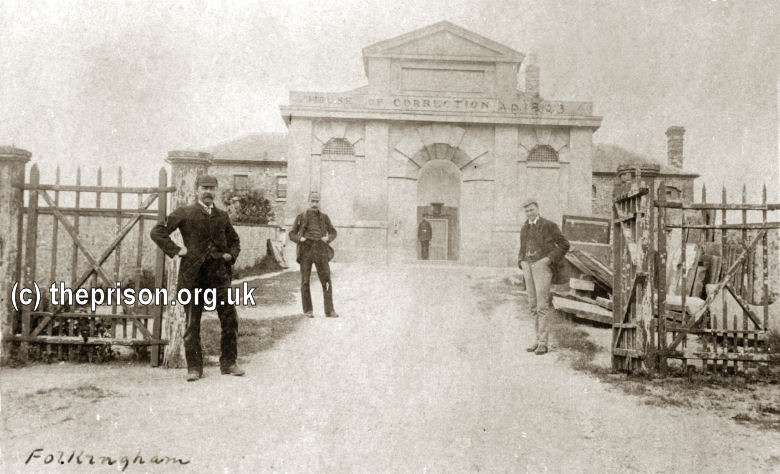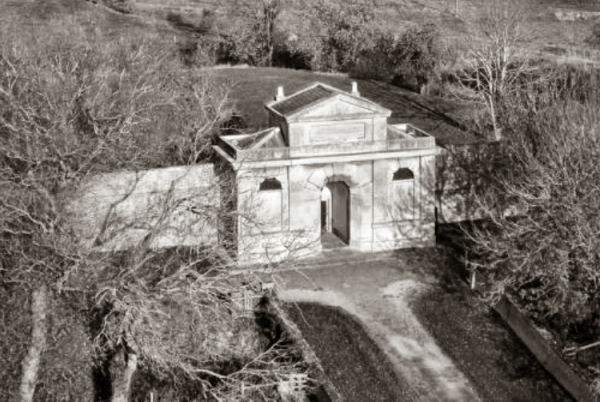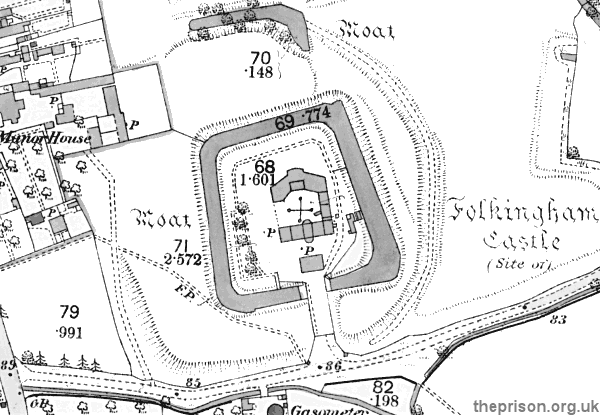County Bridewell, Folkingham, Lincolnshire
A County Bridewell, or House of Correction, serving parts of Kesteven, was established in 1609 on the Market Place in Folkingham (then sometimes also spelled Falkingham).
In 1784, John Howard reported on his visits to the bridewell:
In this prison under the keeper's house are five damp rooms, two of which were used for a lunatic, who was confined here some years. The men's lodging-room (18 feet by 9 feet 9 inches and 6 feet 9 inches high), has only an aperture in the door a foot square into the work-room. The women's room is 13 feet by 8, and 6 feet 2 inches high. In another room 20½ feet by 12 (called the old gaol), you go down by a trap-door in the floor seven steps into a horrid dungeon (10 feet square, 5½ feet high). No chimney: small court: no pump: no fewer. Yet a woman with a child at her breast was sent hither for a year and a day: the child died. Conveyance to quarter sessions at keeper's expence. His salary, £37: out of which he must allow each prisoner six pennyworth of bread a week. Fees, 9s. 4d. no table.
| 1774, Oct. 28, | Prisoners 4. | 1782, Feb. 2, | Prisoners 2. |
| 1779, May 5, | 2. Lunatics 1. |
In 1805, James Neild described the establishment:
John Speight, keeper; salary, 50l. No fees. Surgeon, Mr. Headley; makes a bill. No chaplain or religious attention. Allowance, 10 lbs. of bread per week, and 2s. per week for oatmeal and salt, each prisoner. The oatmeal is boiled with crumbs of bread into porridge, and given to them twice a day in tin pans which hold one quart each. No employ. Men and women have each a separate court-yard, but can see and converse with each other through an aperture in the door a foot square. This prison is under the keeper's house, and consists of four sleeping-cells, about 10 feet square and 6 feet high, which open into a day-room with a fire-place 19 feet by 9, and 6 feet high. Three of the cells have iron gratings in each door, about a foot square, for light and ventilation; the fourth, called the dungeon, is totally dark, having no light nor air but what is admitted by means of four small holes perforated through the door about the size of a pistol-ball. The day-room has three iron-grated and glazed windows; the floors are boarded, and not damp now. The county finds straw on the floor with a rug to each, and firing to the day-rooms. The women have two rooms, about 8 feet square and 6 feet high; the front-room has a fire-place and a glazed window. Prisoners, Aug. 10, 1802, two men, three women, one of them with a child at her breast.
In 1809, the bridewell moved into a new building, erected inside the Folkingham Castle moat, with its entrance on Billingborough Road, Folkingham. The new establishment, intended to serve the whole of Kesteven, was designed by Richard Ingleman. The prisoners' accommodation had a polygonal layout.
In 1812, James Neild described the new building:
Keeper, John Speight. Salary, 50l. Fees, none.
No Chaplain, nor any religious attentions,
Number of Prisoners, 1809, Sept. 4th, 16 Men. 6 Women.
Allowance. Two shillings and six pence per week in bread; one shilling in oatmeal and salt, and one shilling in meat, each.
REMARKS.
This New Prison was first inhabited on the 2d of June 1809. It is built on the site of the antient Castle, and the boundary wall forms an oblong octagon. The entrance gate opens into an area, that detaches the buildings and the court-yards from the boundary wall; close to which here is an inspecting walk, 5 feet wide, encircling the whole Prison.
A flagged foot-path, 8 feet in breadth, leads to the Keeper's house, which occupies the centre of the building, and has a wing on each side of it for the Prisoners; the whole presenting a front 94 feet in length: and a lobby or passage, of 3 feet, divides the house in the middle,
Here are four court-yards, distinctly and equally assigned for the Male and Female Prisoners; to each of which is allotted a day-room, about 12 feet square, and a work room of 12 feet by 6 feet 6. The courts are well supplied with water; the sewers conveniently placed: open iron palisades transmit a thorough air; and a small garden adjacent furnishes the Keeper with vegetables.
On the chamber-story are seven sleeping-cells for Men, and six for Women Prisoners, with vaulted roofs. Some of them have two bedsteads, which are sup plied with straw-in-ticking beds; and two blankets, a pair of sheets, a bolster, and a rug to each.
A circular room, 14 feet in diameter, is appropriated for a Chapel, with two distinct pews for the Prisoners: Adjoining to it is a solitary cell, with a ventilator fixed in the crown of the arch; and the glimmering light which it enjoys is borrowed from the Chapel.
The iron-grated and glazed windows have each an inside shutter, and the cell doors an inspecting wicket, favourable also for the admission of fresh air.
No Turnkey's lodge is provided, nor any assistant for the Keeper: and as two of the court-yards have a view of the entrance-door, it not only seems to render the Prison insecure, but hazardous also to the Keeper.
Here is a good bath; but neither the Act for Preserving Health, nor the Clauses against Spirituous Liquors, are hung up.
The bridewell was enlarged in 1825, with Bryan Browning as architect. An imposing new gatehouse was added. It was intended to house the turnkey and the Governor's horses and carriage.

Folkingham Bridewell, Lincolnshire, early 1900s. © Peter Higginbotham

Bridewell gatehouse, Folkingham, Lincolnshire.
In 1838, the Inspectors of Prisons reported on the premises:
This house of correction is situate at a small distance from the post town of Falkingham, and occupies the site of an ancient fortress, the committals thereto being made "to the Castle." It is a modern elevation of two stories, and surrounded with a boundary wall of brick of octagonal form. The entrance is through a gate of open iron work faced with stone. The lodge at the gate contains apartments for a turnkey, a crank-mill for corn, and a reservoir for supplying the prison with water. The prison originally consisted only of the present frontage, now occupied by the keeper and the female prisoners, but was afterwards enlarged by the addition of a range of buildings in the roar in the form of an attended horseshoe connected at the ends, and leaving an open area between the two, divided into airing yards and a passage to the chapel. The inspection of those yards is from the back of the keeper's house. The dayrooms and tread-wheels occupy the ground floor of the range, and the latter are inspected from the upper story, as from a gallery. The chapel is behind the new buildings, on the ground floor, very damp, and inconveniently small: it contains six pens for the prisoners. The cells for refractory prisoners and solitary confinement are deficient in size and ventilation, and not sufficiently secluded to prevent communication.
The keeper's house contains a room for the magistrates, pantry and kitchen on the ground floor, sitting-room and three chambers above.
The plan of this prison is inconvenient, and its size altogether too small for the number of prisoners frequently confined here. As many as 65 have been inmates at one time. It contains but 30 single cells, inclusive of those for the refractory, and six rooms for the lodging of more than one prisoner.
Very great inconvenience results from the windows of the sleeping cells being opposite to each other, and affording facilities of intercourse, and also from the airing yards for the females being in front of the prison, and exposed to the view of every person at the gate. The former might, be obviated by blinds, and the latter by boarding up the open iron fence. The supply of water for the use of the prison is insufficient, and occasions the most objectionable practice of the prisoners being taken beyond the walls to procure it.
Diet.—.Summer, 1 pint of oatmeal gruel daily, made from 1½ ounce of oatmeal; winter, 2 pints of oatmeal gruel daily, made from 3 ounces of oatmeal.
Convicted prisoners, gruel as above, and 2 lbs. of bread daily for one month, and afterwards the usual diet. All other prisoners, 2 lbs. of bread daily, and ½ lb. of meat and broth on Sundays, which is considered the usual diet. Women, with children, 1 pint of milk and ½ lb. of bread a-day.
Bedding.—Iron bedsteads, palliasse, 2 blankets, and rug.
Fuel—Coals are supplied to the day-rooms in winter only, at the discretion of the keeper.
Clothing.—No clothing issued, except in cases of actual necessity.
Cleanliness.—The prison clean.
Health.—The attendance of the surgeon is as required by illness. He attends corporal punishments, but docs not see the prisoners before they are classed. The prison is generally healthy, the itch the most prevalent disease. The scurvy lately made its appearance among the prisoners. The surgeon states, in explanation, "The prisoners were formerly allowed to have as much salt as they pleased, and used to eat a large quantity, spreading it over their bread. At the same time with the scurvy, there were several cases of strangury, which were difficult to account for but from the salt. I ordered the salt to be taken away, since which there have been no fresh cases of either malady. I have a doubt upon the subject of the dietary. They have a very small quantity of animal food; and, in the event of any new cases of scurvy, I should say the diet ought to be altered. The salt has not been discontinued a sufficient length of time to say whether it has been the sole cause of the scurvy. There is much of simulated disease to avoid the tread-wheel. Prisoners have been put on the tread-wheels with ruptures and, upon complaining have been provided with trusses." The surgeon keeps a journal arranged under the following heads:—Name—disease—when taken—convalescent—diet—dismission—remarks. There have been two deaths during the year.
Moral and Religious Instruction.—The chaplain performs two services, with one sermon, on the Sabbath, and reads prayers two days in the week. The prisoners in solitary confinement do not attend chapel. The chaplain does not see the prisoners individually for the purposes of admonition, nor have the sick in all cases been visited by him. The hours for the performance of divine service are irregular, no precise time being appointed on the Sabbath or the week days. The chaplain distributes tracts and elementary books to the prisoners, provided from the Society for the Promotion of Christian Knowledge. He has never administered the Sacrament in the prison, not having found any prisoner in a state of mind to enable him to do so. A very neat sacramental chalice and patera of silver belongs to the prison, the gift of Sir Montague Cholmeley. It is inscribed "Folkingham Castle, Gift of Sir M. Cholmeley, Bart., 1811," and I believe has never been used.
Classification.—The males are classed according to the provisions of the Gaol Act, but being all mingled together at tho wheel, it may be said, as regards the convicted, to be merely nominal. The females are divided into two classes of untried and convicted. Tho tread-wheel is without partitions. It occasionally happens that there, are several more sentenced to labour than the wheels will hold. The means of inspection there are indifferent, and although silence is enjoined, yet it is very imperfectly observed.
The crank wheel in the lodge is occasionally made use of by the keeper for grinding corn, but its situation is far from secure, and there is a great difficulty of procuring grain for its supply.
The females sentenced to hard labour are put to the coarsest and hardest work, while the untried are employed in lighter offices.
Offences and Punishments.—The ordinary offences are attempts at escape, talking on the wheel, cursing and swearing, punished by solitary confinement.
Scourge.—Common whip handle with nine lashes of small whip-cord, 19 inches long. The punishment inflicted very trifling. Irons, weight 9 lbs.
Visits and Letters.—Visits by order from the magistrates, generally on a Sunday, the day on which the country people have the most leisure. Letters at the discretion of the keeper, but always inspected.
Accounts, Expenditure, Books.—The bread is furnished by contract. The oatmeal is purchased at Hull, in quantities of 80 stone at a time, and is weighed off daily to the prisoners according to their number. The quantity of meat required is too small to be worth supplying by contract, and is therefore bought by the keeper. The bills are sent in quarterly to the keeper, who checks them with the accounts of quantities received, then sends them to the clerk of the peace to be laid before the sessions for approval. The keeper receives the gross amount in money from the treasurer, pays the items, and transmits the bills and receipts to the clerk of the peace.
General Discipline.—An increase of attention on the part of the visiting magistrates to the management of this prison would, I am satisfied, be followed by very beneficial results. The officers are left too much, indeed entirely, to their own discretion, and to this many of the existing irregularities may be traced.
I recommend most strongly that the prisoners should never be taken beyond the walls, as they are now, to clean the moat, to fetch water, or to work in the keeper's field. Upon examining the gums of a prisoner I found his mouth full of tobacco, which he had procured while at work outside. The following account of actual escapes in the years 1836-1837, sufficiently show the insecurity of the practice, even were it free from other objections:—
W. W. a convicted felon, escaped on the 23d day of June 1836, from William Cullen, turnkey, when employed in cleaning out the moat by order of the magistrates, and not retaken.
T. R., a deserter, escaped 23d of January 1837, by scaling the walls, and not retaken.
K U., a convicted felon, escaped 30th October 1837, from Edward Stevenson, turnkey, when fetching water from the moat, and was retaken by the keeper on the 23d day of November 1837.
Keeper.—Age 31; appointed 1834; salary, 100l.; coals, candles, and washing; plot of ground without the walls.
Turnkey.—Age23; appointed 1834; miller; single; salary, 40l.; coals and candles; resides in the lodge; left the prison since.
Turnkey.—Age 28; appointed 1830; coals and candles; resides in prison; read and write.
Matron.—Appointed 1834; wife of the keeper; salary, 20l.
Chaplain.—Appointed 1833; salary, 80l.; curate at Falkingham. Surgeon. Salary, 40l., for medicines and attendance.
The prison site is shown on the 1887 map below.

County Bridewell site, Folkingham, c.1887.
Further additions were made to the buildings in 1849 and 1852.
The establishment was closed following the nationalisation of the prison system in 1878. The site was subsequently sold to a builder who removed the outer wall and converted the prison buildings into cottages. In the 1930s, the gatehouse was also converted to a house, with a brick addition at the back. In the 1960s, the cottages were declared unfit for habitation and were demolished. Only the gatehouse now survives.
The original bridewell on the Market Place has been converted into two houses.
Records
Note: many repositories impose a closure period of up to 100 years for records identifying individuals. Before travelling a long distance, always check that the records you want to consult will be available.
- Lincolnshire Archives, St. Rumbold Street, Lincoln LN2 5AB. Holdings include: Gaoler's return of prisoners committed to Folkingham House of Correction (1823-5); Return of prisoners in Folkingham House of Correction (1824); Return of committals to Folkingham Gaol (1826); Return of prisoners in Folkingham Prison, showing crimes and sentences (1827); Clerk's papers, including reports on the building and its enlargement (1800-66).
- The National Archives, Kew, Richmond, Surrey, TW9 4DU. Has a wide variety of crime and prison records going back to the 1770s, including calendars of prisoners, prison registers and criminal registers.
- Find My Past has digitized many of the National Archives' prison records, including prisoner-of-war records, plus a variety of local records including Manchester, York and Plymouth. More information.
- Prison-related records on
Ancestry UK
include Prison Commission Records, 1770-1951
, and local records from London, Swansea, Gloucesterhire and West Yorkshire. More information.
- The Genealogist also has a number of National Archives' prison records. More information.
Bibliography
- Higginbotham, Peter The Prison Cookbook: A History of the English Prison and its Food (2010, The History Press)
- Brodie, A. Behind Bars - The Hidden Architecture of England's Prisons (2000, English Heritage)
- Brodie, A., Croom, J. & Davies, J.O. English Prisons: An Architectural History (2002, English Heritage)
- Harding, C., Hines, B., Ireland, R., Rawlings, P. Imprisonment in England and Wales (1985, Croom Helm)
- McConville, Sean A History of English Prison Administration: Volume I 1750-1877 (1981, Routledge & Kegan Paul)
- Morris, N. and Rothman, D.G. (eds.) The Oxfod History of the Prison (1997, OUP)
- Pugh R.B. Imprisonment in Medieval England (1968, CUP)
Links
- Prison Oracle - resources those involved in present-day UK prisons.
- GOV.UK - UK Government's information on sentencing, probation and support for families.
Except where indicated, this page () © Peter Higginbotham. Contents may not be reproduced without permission.



